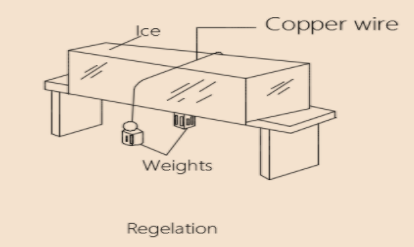
What is regelation?
Answer
584.7k+ views
Hint- Regelation illustrates the idea of melting the ice and turning it into water under pressure and re-solidifies when the pressure is removed.
Complete step by step answer:
The phenomenon in which the ice melts to the water below 0°C on the application of pressure and refreezes back to ice on the removal of pressure is known as Regelation.
For pure substances that are crystalline substances such as ice, naphthalene, etc., the melting and freezing point coincide, whereas, in the case of amorphous substances like iron, glass, wax, etc., fusion and solidification take place over a short range of temperature, so that their melting and freezing point are not fixed with the definiteness. Since the melting and freezing points vary with the different substances.
The phenomenon of melting ice due to excess pressure and its re-solidification after the removal of the excess pressure is called regelation.

When a piece of wire loaded at both ends with equal weights is hanged across a block of ice. It is found that the wire cuts its way through the ice without however dividing the block into two pieces. The reason is that due to the pressure the ice immediately below the wire melts which enable the wire to sink through: but once the pressure is released, the water above the wire solidifies into ice again. It may be noted that the latent heat required to melt the ice below the wire comes from that evolved by the water solidifying above it. Hence, the copper wire will cut through the ice more quickly than an iron wire, because copper is a better conductor of heat than iron.
Additional information:
The quantity of heat required to convert the unit mass of solid at its melting point completely into liquid without change of temperature is called its latent heat of fusion.
The quantity of heat required to convert unit mass of a liquid at its boiling point completely into its vapour without change of temperature is called the latent heat of vaporization.
Note: Some of the examples of the regelation are as follows:
Glaciers act as a source of the river because of the regelation phenomena. The glacier exerts the pressure on the lower surface which lowers down the melting point of the ice at the base. This results in the melting of ice and the glacier sliding over the liquid.
Complete step by step answer:
The phenomenon in which the ice melts to the water below 0°C on the application of pressure and refreezes back to ice on the removal of pressure is known as Regelation.
For pure substances that are crystalline substances such as ice, naphthalene, etc., the melting and freezing point coincide, whereas, in the case of amorphous substances like iron, glass, wax, etc., fusion and solidification take place over a short range of temperature, so that their melting and freezing point are not fixed with the definiteness. Since the melting and freezing points vary with the different substances.
The phenomenon of melting ice due to excess pressure and its re-solidification after the removal of the excess pressure is called regelation.

When a piece of wire loaded at both ends with equal weights is hanged across a block of ice. It is found that the wire cuts its way through the ice without however dividing the block into two pieces. The reason is that due to the pressure the ice immediately below the wire melts which enable the wire to sink through: but once the pressure is released, the water above the wire solidifies into ice again. It may be noted that the latent heat required to melt the ice below the wire comes from that evolved by the water solidifying above it. Hence, the copper wire will cut through the ice more quickly than an iron wire, because copper is a better conductor of heat than iron.
Additional information:
The quantity of heat required to convert the unit mass of solid at its melting point completely into liquid without change of temperature is called its latent heat of fusion.
The quantity of heat required to convert unit mass of a liquid at its boiling point completely into its vapour without change of temperature is called the latent heat of vaporization.
Note: Some of the examples of the regelation are as follows:
Glaciers act as a source of the river because of the regelation phenomena. The glacier exerts the pressure on the lower surface which lowers down the melting point of the ice at the base. This results in the melting of ice and the glacier sliding over the liquid.
Recently Updated Pages
Why are manures considered better than fertilizers class 11 biology CBSE

Find the coordinates of the midpoint of the line segment class 11 maths CBSE

Distinguish between static friction limiting friction class 11 physics CBSE

The Chairman of the constituent Assembly was A Jawaharlal class 11 social science CBSE

The first National Commission on Labour NCL submitted class 11 social science CBSE

Number of all subshell of n + l 7 is A 4 B 5 C 6 D class 11 chemistry CBSE

Trending doubts
10 examples of friction in our daily life

One Metric ton is equal to kg A 10000 B 1000 C 100 class 11 physics CBSE

Difference Between Prokaryotic Cells and Eukaryotic Cells

1 Quintal is equal to a 110 kg b 10 kg c 100kg d 1000 class 11 physics CBSE

State the laws of reflection of light

Explain zero factorial class 11 maths CBSE




